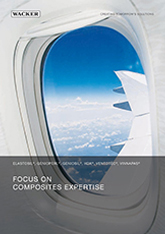Composite Molding

Large number of reproductions: the bags (approx. 4x3 m) can be rolled up for transportation and used again and again. This bag has already beed used 250 times.
From aeronautic, through transportation to consumer goods, many application areas are now unimaginable without fiber-reinforced plastic composites. WACKER silicone rubbers and fabrics for re-usable vacuum bags improve the composite resin infusion molding process. These silicone bags are placed quickly and securely over the mold before each part is produced. Repeated, time-consuming sealing with conventional vacuum film is no longer necessary.

Benefits of Silicone Bag Technology:
- Faster production
- Better repeatability and quality
- Lower emissions of volatile components
- Less waste
- Less labor intensive
Benefits of ELASTOSIL®:
- Flexible
- Yet self-leveling
- Longer pot life and curing time
- Suitable for large surfaces
- Suitable for vertical surfaces
- Reusable
Silicones are also used for the production of wedges or bladders, used to apply pressure to the composite during the manufacturing process. Re-usability and release properties together with good chemical resistance are the key advantages here.




